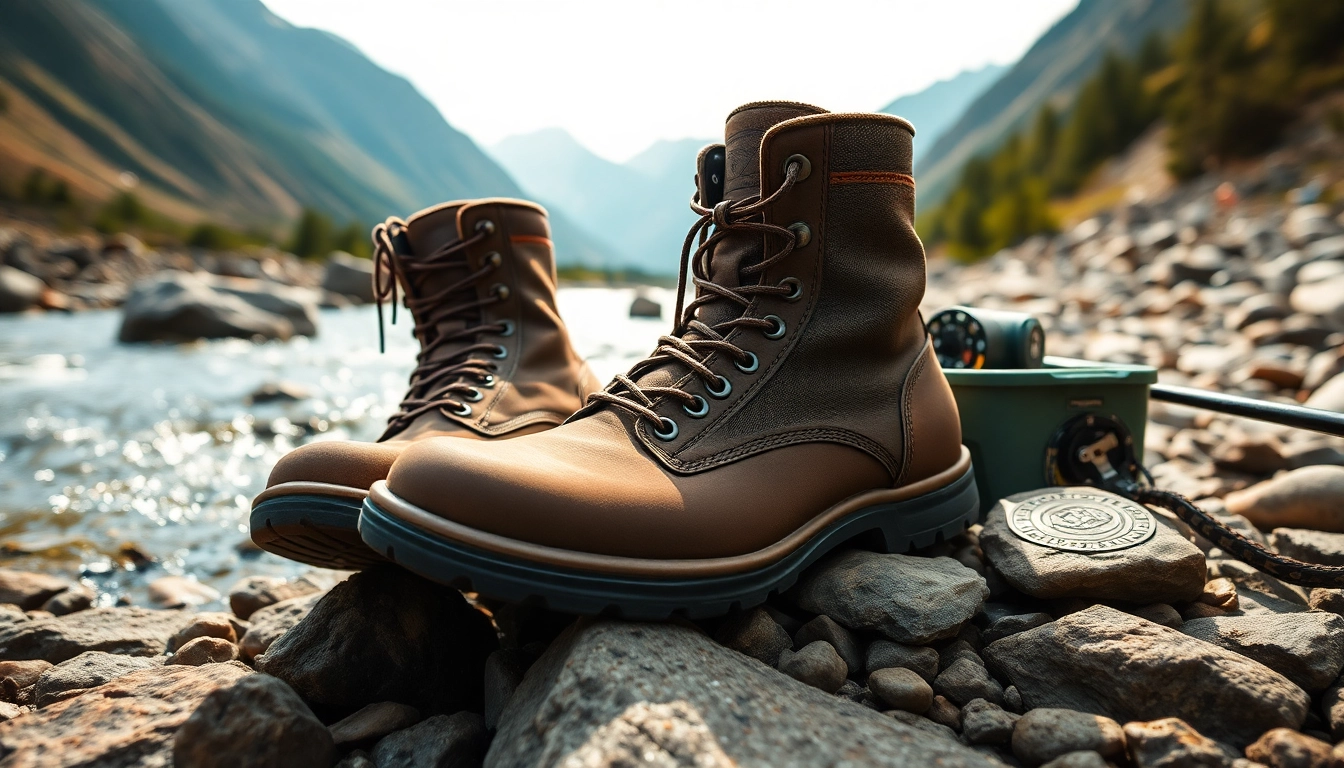Understanding the Importance of Fly Fishing Boots
When venturing into the world of fly fishing, proper gear can make all the difference. Among the many essential items, fly fishing boots play a critical role in ensuring both comfort and safety. Fishing spots are often slippery, rocky, or muddy, necessitating footwear designed for rugged environments. The right fly fishing boots provide support, protection, and improved performance, allowing anglers to focus on their technique rather than their footing.
Benefits of Proper Footwear for Fly Fishing
The benefits of investing in appropriate fly fishing boots extend far beyond mere comfort. Proper footwear enhances stability, prevents injuries, and improves overall fishing performance. It allows anglers to traverse challenging terrains, whether they’re wading through cold streams or trekking up rocky riverbanks. With sturdy and well-designed boots, you can maintain traction on slippery rocks, reducing the risk of slips and falls.
Different Types of Fly Fishing Boots
There is a wide array of fly fishing boots available, each designed to cater to specific needs and preferences. Here are some common types:
- Wading Boots: Specifically designed for wading in water, they typically feature felt or rubber soles for enhanced traction.
- Chest Waders with Boots: These provide full coverage and are ideal for deeper wading, offering insulation and protection against cold water.
- Bootfoot Waders: These integrate boots into the wader design, providing a seamless fit and added warmth, often used in colder climates.
Understanding these options can aid fishermen in selecting boots that best suit their fishing style and local conditions.
Key Features to Look for in Fly Fishing Boots
When choosing fly fishing boots, certain features are essential for maximizing your time on the water:
- Traction: Look for boots with excellent traction to help prevent slipping on wet and uneven surfaces.
- Material: Waterproof and breathable materials ensure your feet stay dry and comfortable throughout the day.
- Support: Boots should offer good ankle support, especially when navigating tricky terrains.
- Drainage: Integrated drainage systems can prevent water from accumulating inside the boot.
These features collectively contribute to an enhanced fishing experience, allowing you to focus on what matters most—catching fish.
Materials and Construction of Fly Fishing Boots
The construction materials of fly fishing boots significantly influence their performance and durability. Understanding these materials can help you make an informed choice.
Overview of Common Materials Used
Fly fishing boots are typically made from a combination of synthetic materials, rubber, and neoprene. Each of these materials has distinct characteristics:
- Neoprene: Known for its insulation properties, neoprene is often used in waders and boots meant for colder environments. It’s water-resistant and helps keep feet warm.
- Rubber: A popular choice for sole material, rubber provides excellent grip and durability. It’s also less permeable, preventing water from seeping in.
- Synthetic Fabrics: Lightweight and breathable synthetic materials are often used in combination with waterproof membranes to keep feet dry while providing comfort.
Comparative Durability: Rubber vs. Neoprene
When it comes to durability, rubber soles generally outperform neoprene, especially concerning wear and tear on rocky surfaces. However, neoprene offers unparalleled warmth and cushioning, making it ideal for fishing in colder waters. Depending on your fishing environment, you may choose to prioritize one material over the other, or opt for a boot that cleverly combines both.
Construction Techniques for Comfort
The construction process of fly fishing boots also influences comfort. Features such as cushioned footbeds, arch support, and padded collars are essential for providing the support needed during long fishing trips. High-quality stitching and sealed seams can also enhance the waterproof nature of boots, preventing any unwanted leaks while ensuring longevity.
How to Choose Fly Fishing Boots That Fit
Ensuring an ideal fit is crucial for comfort and performance in fly fishing. Ill-fitting boots can lead to blisters, discomfort, and decreased mobility.
Assessing Size and Fit for Optimal Comfort
The first step in finding the right fly fishing boots is to accurately assess your size. Measure your feet in both length and width to determine the best size. Consider trying on boots wearing the socks you’ll use while fishing, as this can influence fit. A snug fit is key—boots should feel secure but not too tight, allowing for good blood circulation.
Trying on Fly Fishing Boots: What to Look For
When trying on boots, pay attention to several criteria:
- Heel Fit: Ensure the heel sits securely without slipping.
- Toe Room: There should be enough space for your toes to move without being cramped.
- Ankle Support: Boots should support your ankles firmly, especially when standing or walking on uneven surfaces.
Customizable Options for Unique Needs
Some fly fishing boots offer customizable features, such as removable insoles or adjustable straps that cater to individual foot shapes and sizes. If you have specific requirements, such as orthotic needs, look for brands that allow these customizations for a more tailored fit.
Care and Maintenance of Fly Fishing Boots
Proper care and maintenance can significantly extend the lifespan of your fly fishing boots, ensuring you get the most out of your investment.
Cleaning Techniques to Extend Lifespan
After every fishing trip, it’s essential to clean your boots to remove dirt, sand, and salt that can degrade materials over time. Start by rinsing the boots with warm water, using a soft brush or cloth to scrub away stubborn debris. If using soap, choose a gentle cleaner to avoid damaging waterproofing treatments. Ensure the boots dry completely before storing them to prevent mold and mildew.
Storage Tips for Off-Season
Storing your fly fishing boots correctly during the off-season is equally vital. Keep them in a cool, dry place, away from direct sunlight, which can cause materials to degrade. Avoid compressing them by placing them upright or stuffing them with newspaper to help maintain their shape.
Repairing Minor Damages
Minor damages such as scratches or small leaks can often be repaired at home. For small tears, waterproof adhesive can be effective. Ensure the area is clean and dry before applying any adhesive. For scratched rubber soles, light sanding can remove rough edges, prolonging the life of the boot. Knowing how to perform these small repairs allows you to maximize the usability of your boots.
Top Brands in Fly Fishing Boots: Market Overview
Understanding the key players in the fly fishing boot market can help you make informed choices. While specific brands are not highlighted here, there are certain features and qualities that set leading manufacturers apart.
Features That Set Leading Brands Apart
Some features that typically distinguish the leading brands are advanced technology in materials, innovative designs, and specialized sole configurations for superior grip and comfort. Brands that undergo continuous testing in real fishing environments often produce boots that outperform competitors in durability and comfort.
Comparative Analysis of Price vs. Quality
When evaluating fly fishing boots, a direct correlation exists between price and quality. Higher-priced boots often feature better materials and construction techniques. However, it’s important to assess whether the price aligns with your intended usage and how frequently you fish. In many cases, investing in quality pays off in durability and comfort over time.
User Reviews and Feedback on Popular Choices
Feedback from fellow anglers can provide valuable insights into the performance of various fly fishing boots. Reading reviews and testimonials often reveals details that advertisements do not, such as comfort during extended wear, durability under specific conditions, and maintenance requirements. Always consider user experiences as a part of your decision-making process.



